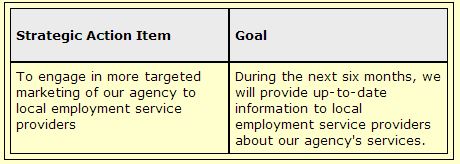 Decision-Making
Decision-Making
Deciding Our Next Steps
Decision-making is Step 3 in the strategic planning process. In this step, what you want to discover is what are we going to do based on what we have learned?
You now have some decisions to make. You are about to choose what your agency will focus on over the next few years. There are probably several options or combinations of options that are open to you, but which ones are best? Given the ratings you assigned to the various items identified during assessment, and given your current mandated activity, your agency resources, and current capacity, what decisions are going to produce the best results for your agency?
Some decisions have been made for you already such as those found in the agency’s business plan and other mandated activities that you cannot change. Other decisions you can make now, however, are related to actions your agency could take to make necessary improvements or to move forward into new ventures. These are the things you want to identify now.
Key steps in the decision-making process
To help you make decisions about final priorities, you need to:
- Identify key items that require attention and will appear as strategic action items on the final plan
- Set goals for each strategic action item
Choosing your strategic action items
- Locate on your evaluation chart all items that are coded red (and possibly orange). These represent your critical issues and opportunities. Some may be negatives that require action to correct. Some may be positives, i.e. new ventures the agency wants to pursue.
- Select the most important items. Given the agency’s current workload, commitments and mandated activities, you may not be able to respond to everything on the list. In that case, you will have to make choices. In your professional opinion, what would be the strategic choice? It is strengthening your internal environment in order to build capacity for the future, moving the agency forward on a timely opportunity in the community, or working on a combination of both but paced out over a longer period of time and in smaller “chunks”? Which items will bring you the greatest benefit? Which items if left undone will cause the most harm?
- Based on a review of the above, decide and make a list of the key strategic actions your agency will be pursing over the next while. (See the sample chart below)
- Invite your key stakeholders to review these choices and provide feedback. We cannot emphasize enough the importance of coming to a common agreement with key players on the priorities for the next few years. Key players in most agencies include learners, staff, members of the board and volunteers.
Setting goals
Once you have identified the strategic action items the agency will pursue, you need to identify goals for each action item. Exactly what will this strategic action achieve? What is the expected, measurable and achievable outcome of this strategic action, i.e. what will be new or different as a result of your work?
Documenting this information is key because it sets a framework in place for measuring success. After time has passed, you will be able to look back and say, “This is where we were then, this is what we did, and here is where we are now. Look what has been accomplished.”
Sample Strategic Action / Goals Chart
Key Strategic Actions Items to Pursue / Goals

- For picking your strategic action items…
- Limit your strategic action items to what you know you can achieve in the time you have available.
- If your strategic plan extends over several years, prioritize the action items and order them according to what you plan to focus on year by year.
- Your strategic plan is not set in stone. It is a flexible document; and changes can be made whenever necessary. This will take the pressure off any need to produce a perfect plan.
For setting your goals …
When writing your goals, make sure they meet the SMART criteria and are:
- Specific
- Measurable
- Action-oriented
- Realistic
- Time-defined
Next steps
After selecting your strategic action items and related goals the next step is implementation. Implementation involves making decisions about how the strategic action items will unfold, who will carry out these actions and when they will take place. That information produces a concrete implementation plan the agency can follow. We will look at that piece next.
- How will you determine if your strategic action items and goals are achievable?
- How will you make sure your goals are specific, measurable, action-oriented, realistic and time-defined?
- How many goals can you reasonably work toward at this time? If you have more goals than you can cope with now, how will you prioritize?
- How might you incorporate stakeholder feedback into the strategic action items goals you chose to pursue?





